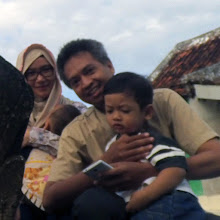When we talk about the geological changes, it always in the geological-time-scale, they mean the change happens over the course of millions of years. Grand Canyon is one of the examples, where the Colorado River gradually cuts through the soft rock of the Colorado Plateau until it has made a 4,000-foot deep chasm. Most of the time, and most of the geological phenomenons, change is slow.
But sometimes, in some spesific and unusual conditions, geologic change happens all at once. This was what happen on Ranongga Island in the Solomon islands after the strong earthquake followed by the tsunami. The huge quake pushed much of the island up, raising the coral reefs that ringed the island above the water. In the course of a few minutes, Ranongga Island acquired several meters of new beach.
From the image belows, image acquired by the Advanced Spaceborne Thermal Emission and Reflection Radiometer (ASTER), we all can see the changes.

 When ASTER took the 2007 image, the tide was 29.4 centimeters higher than it was when the 2006 image was taken, and yet the uplift is still visible. The lush vegetation that covers the tropical island is bright red in this image, which is made from both visible and infrared light. So, the change could be more drmatic than "the simple picture" above.
When ASTER took the 2007 image, the tide was 29.4 centimeters higher than it was when the 2006 image was taken, and yet the uplift is still visible. The lush vegetation that covers the tropical island is bright red in this image, which is made from both visible and infrared light. So, the change could be more drmatic than "the simple picture" above.Such evolution is common in earthquake zones in the Pacific and Indian Oceans. During the December 26, 2004, earthquake that generated the massive Indian Ocean tsunami, Simeulue Island was lifted as much as 150 centimeters (4.9 feet), exposing the reef that surrounded it.
 In the picture, mounds of coral that were thrust out of the water by the quake died back to the water line. In locations where satellite images weren’t available, often because of persistent clouds, Meltzner and his colleagues relied on field measurements of the amount of uplift of coral mounds. Here a scientist measures coral uplift around Simeulue Island. (Photo copyright © John Galetzka.)
In the picture, mounds of coral that were thrust out of the water by the quake died back to the water line. In locations where satellite images weren’t available, often because of persistent clouds, Meltzner and his colleagues relied on field measurements of the amount of uplift of coral mounds. Here a scientist measures coral uplift around Simeulue Island. (Photo copyright © John Galetzka.)And it wasn't "enough". We can look at the geologic changes after the huge earthquake at the end of 2004 from the images below.
 Through a combination of satellite imagery and field measurements, Meltzner and his colleagues developed a comprehensive picture of subsidence and uplift resulting from the Aceh quake. Colored dots represent estimates of minimum uplift or subsidence (sinking). The dashed line is the estimated pivot line, on either side of which the earth either rose or fell. Land predominantly sank around the Nicobar Islands, both sank and rose around the Andaman Islands, and predominantly rose around Simeulue Island. The satellite-based map showed that the earthquake rupture stretched nearly 1,600 kilometers along the fault—100 kilometers farther north than previous estimates suggested. (Map adapted from Meltzner et al., 2006.)
Through a combination of satellite imagery and field measurements, Meltzner and his colleagues developed a comprehensive picture of subsidence and uplift resulting from the Aceh quake. Colored dots represent estimates of minimum uplift or subsidence (sinking). The dashed line is the estimated pivot line, on either side of which the earth either rose or fell. Land predominantly sank around the Nicobar Islands, both sank and rose around the Andaman Islands, and predominantly rose around Simeulue Island. The satellite-based map showed that the earthquake rupture stretched nearly 1,600 kilometers along the fault—100 kilometers farther north than previous estimates suggested. (Map adapted from Meltzner et al., 2006.)And maybe the geologic changes above, can lead us to another geologic phenomenon, Mud Volcano, happens also in Indonesia, at Sidoarjo. What kind of geologic changes will it come ???
news and article source : http://earthobservatory.nasa.gov

No comments:
Post a Comment